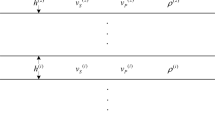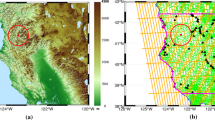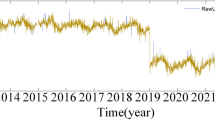Abstract
Southeastern (SE) Tibet on the Chinese mainland is geologically active and plays an important role in subsurface deformation and mass transfers. Hybrid gravimetry using both absolute and relative gravimeters is an efficient tool for monitoring surface and underground mass transfers. But for hybrid gravity network surveys, uncertainties are influenced by measurement errors, while sparseness of the network and environmental artifacts must be identified and minimized prior to studying gravity change. In this study, Bayesian gravity adjustment (BGA) was applied for the first time to the hybrid gravity network in SE Tibet during 2014–2016, which effectively reduced measurement uncertainties via its estimated scale factors and drift rates, thereby demonstrating its suitability for the large and complex gravity network in SE Tibet. To estimate the field source resolution, reduce environmental artifacts, and invert mass redistributions on the deep crust, an equivalent source inversion (ESI) based on the spatiotemporal smoothness regularization constraint model and the Akaike Bayesian information criterion parameter estimation method was applied to datasets processed by BGA. With respect to processing synthetic gravity data with spatiotemporal noises, the ESI was an effective algorithm, with the optimal field source resolution in SE Tibet being 0.75° × 0.75°. The apparent density change at a depth of 20 km was then inverted, with an average rate of −0.6 to 0.6 kg/m3/year, which was approximately 0.22‰ of the average crustal density. In addition, its spatial distribution showed close consistency with active tectonic block boundaries and low-velocity/high-conductivity zones. Comprehensively considering the hydrological effects, GPS observation studies, and geophysical and petrological evidence in the region, this study suggests that the crustal mass redistributions in SE Tibet are possibly controlled by active tectonic block boundaries and fluids distributed in the deep crust.

















Similar content being viewed by others
References
Akaike, H. (1980). Likelihood and the Bayes procedure. In J. M. Bernardo, M. H. DeGroot, D. V. Lindley, & A. F. M. Smith (Eds.), Bayesian statistics (pp. 143–166). University Press.
Bai, D. H., Unsworth, M. J., Meju, M. A., Ma, X. B., Teng, J. W., Kong, X. R., Sun, Y., Sun, J., Wang, L. F., Jiang, C. S., Zhao, C. P., Xiao, P. F., & Liu, M. (2010). Crustal deformation of the eastern Tibetan plateau revealed by magnetotelluric imaging. Nature Geoscience, 3(5), 358–362.
Barnes, D. F. (1966). Gravity changes during the Alaska earthquake. Journal of Geophysical Research, 71, 451–456.
Beaudoing, H., & Rodell, M. NASA/GSFC/HSL (2020), GLDAS Noah Land Surface Model L4 monthly 0.25 × 0.25 degree V2.1, Greenbelt, Maryland, USA, Goddard Earth Sciences Data and Information Services Center (GES DISC). https://doi.org/10.5067/SXAVCZFAQLNO
Boddice, D., Atkins, P., Rodgers, A., Metje, N., Goncharenko, Y., & Chapman, D. (2018). A novel approach to reduce environmental noise in microgravity measurements using a Scintrex CG5. Journal of Applied Geophysics, 152, 221–235.
Bramanto, B., Breili, K., Gerlach, C., Ophaug, V., & Gjevestad, J. G. O. (2022). Reducing hydrological disturbances in absolute gravity observations by combining global hydrological models with a regional runoff model. Geophysical Journal International. https://doi.org/10.1093/gji/ggac054
Chao, B. F., & Liau, J. R. (2019). Gravity changes due to large earthquakes detected in GRACE satellite data via empirical orthogonal function analysis. Journal of Geophysical Research: Solid Earth, 124, 3024–3035. https://doi.org/10.1029/2018JB016862
Chen, J., Pan, E., & Bevis, M. (2018). Accurate computation of the elastic load Love numbers to high spectral degree for a finely layered, transversely isotropic and self-gravitating Earth. Geophysical Journal International, 212(2), 827–838. https://doi.org/10.1093/gji/ggx444
Chen, S., Jiang, C., & Zhuang, J. (2016a). Statistical evaluation of efficiency and possibility of earthquake predictions with gravity field variation and its analytic signal in western China. Pure and Applied Geophysics, 173(1), 305–319.
Chen, S., Liu, M., Xing, L. L., Xu, W. M., Wang, W. X., Zhu, Y. Q., & Li, H. (2016b). Gravity increase before the 2015 M-w 7.8 Nepal earthquake. Geophysical Research Letters, 43(1), 111–117.
Chen, S., Zhuang, J. C., Li, X. Y., Lu, H. Y., & Xu, W. M. (2019). Bayesian approach for network adjustment for gravity survey campaign: Methodology and model test. Journal of Geodesy, 93(5), 681–700.
Chen, Y. T., Gu, H. D., & Lu, Z. X. (1979). Variations of gravity before and after the Haicheng earthquake 1975, and the Tangshan earthquake, 1976. Physics of the Earth and Planetary Interiors, 18(4), 330–338.
Cheraghi, H., Hinderer, J., Saadat, S. A., Bernard, J. D., Djamour, Y., Tavakoli, F., Arabi, S., & Kohan, N. A. (2020). Stability of the calibration of Scintrex relative gravimeters as inferred from 12 years of measurements on a large amplitude calibration line in Iran. Pure and Applied Geophysics, 177(2), 991–1004.
Crossley, D., Hinderer, J., & Riccardi, U. (2013). The measurement of surface gravity. Reports on Progress in Physics, 76(4), 046101.
Debeglia, N., & Dupont, F. (2002). Some critical factors for engineering and environmental microgravity investigations. Journal of Applied Geophysics, 50(4), 435–454.
Farrell, W. (1972). Deformation of the earth by surface loads. Reviews of Geophysics and Space Physics, 10, 761–797.
Feng, W., Shum, C. K., Zhong, M., & Pan, Y. (2018). Groundwater storage changes in China from satellite gravity: An overview. Remote Sensing, 10(5), 674.
Ferguson, J. F., Chen, T., Brady, J., Aiken, C. L. V., & Seibert, J. (2007). The 4D microgravity method for waterflood surveillance II—Gravity measurements for the Prudhoe Bay reservoir, Alaska. Geophysics, 72(2), I33–I43.
Humphreys, E., & Clayton, R. W. (1988). Adaptation of back projection tomography to seismic travel time problems. Journal of Geophysical Research-Solid Earth, 93, 1073–1085.
Kennedy, J. R., & Ferre, T. P. A. (2016). Accounting for time- and space-varying changes in the gravity field to improve the network adjustment of relative-gravity data. Geophysical Journal International, 204(2), 892–906.
Kuo, J. T., Zeng, J. H., Song, S. H., & Liu, K. R. (1999). Determination of earthquake epicentroids by inversion of gravity change data in BTTZ region, China. Tectonophysics, 312, 267–281.
Liu, Q. Y., van der Hilst, R. D., Li, Y., Yao, H. J., Chen, J. H., Guo, B., Qi, S. H., Wang, J., Huang, H., & Li, S. C. (2014). Eastward expansion of the Tibetan Plateau by crustal flow and strain partitioning across faults. Nature Geoscience, 7(5), 361–365.
Liu, Y., Yao, H. J., Zhang, H. J., & Fang, H. J. (2021). The Community Velocity Model V.1.0 of Southwest China, Constructed from Joint Body- and Surface-Wave Travel-Time Tomography. Seismological Research Letters, 92(5), 2972–2987.
Melchior, P. (1983). The tides of the planet earth. Pergamon Press.
Merriam, J. B. (1992). Atmospheric pressure and gravity. Geophysical Journal International, 109, 488–500.
Micro-g LaCoste Inc. (2013). g-software Absolute Gravity Data Acquisition and Processing Software version 9 User’s Manual. http://www.microglacoste.com/g9Downloads/g9Help.pdf
Mouyen, M., Chao, B. F., Hwang, C., & Hsieh, W. C. (2016). Gravity monitoring of Tatun Volcanic Group activities and inference for underground fluid circulations. Journal of Volcanology and Geothermal Research, 328, 45–58.
Mouyen, M., Masson, F., Hwang, C., Cheng, C. C., Le Moigne, N., Lee, C. W., Kao, R., & Hsieh, W. C. (2013). Erosion effects assessed by repeated gravity measurements in southern Taiwan. Geophysical Journal International, 192(1), 113–136.
Nelder, J. A., & Mead, R. (1965). A simplex method for function minimization. The Computer Journal, 7(4), 308–313.
Onizawa, S. (2019). Apparent calibration shift of the Scintrex CG-5 gravimeter caused by reading-dependent scale factor and instrumental drift. Journal of Geodesy, 93(9), 1335–1345.
Pagiatakis, S. D., & Salib, P. (2003). Historical relative gravity observations and the time rate of change of gravity due to postglacial rebound and other tectonic movements in Canada. Journal of Geophysical Research-Solid Earth, 108, 2406.
Reudink, R., Klees, R., Francis, O., Kusche, J., Schlesinger, R., Shabanloui, A., Sneeuw, N., & Timmen, L. (2014). High tilt susceptibility of the Scintrex CG-5 relative gravimeters. Journal of Geodesy, 88(6), 617–622.
Rodell, M., Houser, P. R., Jambor, U., Gottschalck, J., Mitchell, K., Meng, C., Arsenault, K., Cosgrove, B., Radakovich, J., Bosilovich, M., Entin, J. K., Walker, J. P., Lohmann, D., & Toll, D. (2004). The global land data assimilation system. Bulletin of the American Meteorological Society, 85, 381–394. https://doi.org/10.1175/BAMS-85-3-381
Royden, L. H., Burchfiel, B. C., King, R. W., Wang, E., Chen, Z., Shen, F., & Liu, Y. (1997). Surface deformation and lower crustal flow in Eastern Tibet. Science, 276(5313), 788–790.
Schrama, E. J. O., Wouters, B., & Lavallee, D. A. (2007). Signal and noise in Gravity Recovery and Climate Experiment (GRACE) observed surface mass variations. Journal of Geophysical Research-Solid Earth, 112(B8), 3126–3141.
Shen, Z. K., Lu, J. N., Wang, M., & Burgmann, R. (2005). Contemporary crustal deformation around the southeast borderland of the Tibetan Plateau. Journal of Geophysical Research-Solid Earth, 110(B11), B11409.
Sun, W. K., Wang, Q., Li, H., Wang, Y., Okubo, S. H., Shao, D. S., Liu, D. Z., & Fu, G. Y. (2009). Gravity and GPS measurements reveal mass loss beneath the Tibetan Plateau: Geodetic evidence of increasing crustal thickness. Geophysical Research Letters, 36, L02303.
Van Camp, M., de Viron, O., Watlet, A., Meurers, B., Francis, O., & Caudron, C. (2017). Geophysics from terrestrial time-variable gravity measurements. Review of Geophysics, 55(4), 938–992.
Van Camp, M., Metivier, L., de Viron, O., Meurers, B., & Williams, S. D. P. (2010). Characterizing long-time scale hydrological effects on gravity for improved distinction of tectonic signals. Journal of Geophysical Research-Solid Earth, 115, B07407.
Van Camp, M., Williams, S. D. P., & Francis, O. (2005). Uncertainty of absolute gravity measurements. Journal of Geophysical Research-Solid Earth, 110(B5), B05406.
Wahr, J., Molenaar, M., & Bryan, F. (1998). Time variability of the Earth’s gravity field: Hydrological and oceanic effects and their possible detection using GRACE. Journal of Geophysical Research: Solid Earth, 103, 30205–30229. https://doi.org/10.1029/98JB02844
Wahr, J. M. (1985). Deformation induced by polar motion. Journal of Geophysical Research, 90, 9363–9368.
Wang, C. Y., Yang, W. C., Wu, J. P., & Ding, Z. F. (2015). Study on the lithospheric structure and earthquakes in North-South Tectonic Belt. Chinese Journal of Geophysics-Chinese Edition, 58(11), 3867–3901.
Wang, L. H., Chen, S., Zhuang, J. C., & Xu, W. M. (2022). Simultaneous calibration of instrument scale factor and drift rate in network adjustment for continental-scale gravity survey campaign. Geophysical Journal International, 228(3), 1541–1555.
Wang, L. S., Peng, Z. R., Ma, X., Zheng, Y. H., & Chen, C. (2021). Multiscale gravity measurements to characterize 2020 flood events and their spatio-temporal evolution in Yangtze river of China. Journal of Hydrology, 603, 127176.
Wessel, P., Smith, W. H. F., Scharroo, R., Luis, J., & Wobbe, F. (2013). Generic mapping tools: Improved version released. Eos, Transactions American Geophysical Union, 94(45), 409–410. https://doi.org/10.1002/2013EO450001
Williams, S. D. P. (2003). The effect of coloured noise on the uncertainties of rates estimated from geodetic time series. Journal of Geodesy, 76(9–10), 483–494.
Williams-Jones, G., Rymer, H., Mauri, G., Gottsmann, J., Poland, M., & Carbone, D. (2008). Toward continuous 4D microgravity monitoring of volcanoes. Geophysics, 73(6), WA19–WA28.
Xiang, L. W., Wang, H. S., Steffen, H., Wu, P., Jia, L. L., Jiang, L. M., & Shen, Q. (2016). Groundwater storage changes in the Tibetan Plateau and adjacent areas revealed from GRACE satellite gravity data. Earth and Planetary Science Letters, 449, 228–239.
Xing, L. L., Wang, L. H., & Hu, M. Z. (2017). Determination of mantle upwelling rate beneath Taiyuan basin by using absolute gravity, GPS, groundwater and GLDAS data. Journal of Applied Geophysics, 138, 179–184.
Xuan, S. B., Jin, S. G., Chen, Y., & Wang, J. P. (2019). Insight into the preparation of the 2016 M(S)6.4 Menyuan earthquake from terrestrial gravimetry-derived crustal density changes. Scientific Reports, 9, 1–10.
Zhan, F., Zhu, Y., Ning, J., Zhou, J., Liang, W., & Xu, Y. (2011). Gravity changes before large earthquakes in China: 1998–2005. Geo-Spatial Information Science, 14(1), 1–9. https://doi.org/10.1007/s11806-011-0440-0
Zhang, B., Chen, S., Li, H. L., Yang, J. L., Han, J. C., & Lu, H. Y. (2021). Time-varying gravity inversion using spherical model and synthetic test. Earthquake, 41(1), 13–24 (in Chinese).
Zhang, H., & Thurber, C. H. (2007). Estimating the model resolution matrix for large seismic tomography problems based on Lanczos bidiagonalization with partial reorthogonalization. Geophysical Journal International, 170(1), 337–345.
Zhang, P. Z. (2013). A review on active tectonics and deep crustal processes of the Western Sichuan region, eastern margin of the Tibetan Plateau. Tectonophysics, 584, 7–22.
Zhu, Y. Q., Zhang, Y., Zhang, G. Q., Liu, F., & Zhao, Y. F. (2020). Gravity variations preceding the large earthquakes in the Qinghai-Tibet Plateau from 21st century. Chinese Science Bulletin, 65(7), 622–632.
Acknowledgements
The authors thank the Gravity Network Centre of China (GNCC) (http://www.gncc.ac.cn/) for providing the datasets of hybrid gravity surveys. The authors would like to thank Dr. Jiancheng Han for help with the computation of hydrological effects. The authors also would like to thank Dr. Severine Rosat and two anonymous reviewers for their constructive comments and suggestions that significantly helped us to improve our manuscript. An Open-Source Geophysical Python Library for Geoscience Prototype Research (https://github.com/igp-gravity/geoist) provided support for Bayesian gravity adjustment and inversion in this study. All figures were generated using the Generic Mapping Tools (Wessel et al., 2013).
Funding
This research was supported financially by the National Natural Science Foundation of China (Grants U1939205, 41974095, 41774090, and 41804091), the Earthquake Science and Technology Spark Plan Project (XH20078Y), and the Beijing Baijiatuan Earth Science National Observation and Research Station.
Author information
Authors and Affiliations
Contributions
Conceptualization, ZC and SC; methodology, SC; software, BZ, LW, and SC; data curation, ZC and HL; figures and tables, ZC; writing—original draft preparation, ZC; writing—review and editing, ZC, SC, LS, WX, and JL. All authors have read and agreed to the published version of the manuscript.
Corresponding author
Ethics declarations
Conflict of interest
The authors declare that they have no conflict of interest.
Additional information
Publisher's Note
Springer Nature remains neutral with regard to jurisdictional claims in published maps and institutional affiliations.
Rights and permissions
About this article
Cite this article
Chen, Z., Chen, S., Zhang, B. et al. Uncertainty Quantification and Field Source Inversion for the Continental-Scale Time-Varying Gravity Dataset: A Case Study in SE Tibet, China. Pure Appl. Geophys. 180, 683–702 (2023). https://doi.org/10.1007/s00024-022-03095-9
Received:
Revised:
Accepted:
Published:
Issue Date:
DOI: https://doi.org/10.1007/s00024-022-03095-9




